Financial factors in the boom-bust episode in Finland in the late 1980s and early 1990s
Freystätter, Hanna (01.01.2011)
Numero
1/2011Julkaisija
Bank of Finland
2011
Julkaisun pysyvä osoite on
https://urn.fi/URN:NBN:fi:bof-20140807302Tiivistelmä
This paper proposes a framework for studying the boom and bust in Finland in the late 1980s and early 1990s. We develop a small open economy DSGE model with balance sheet-constrained firms à la BGG and calibrate it to the Finnish economy. We use the model to simulate three events that are claimed to have played a key role in the Finnish boom-bust episode and compare the model outcome with actual Finnish data. Firstly, we assess in our DSGE framework the role of financial market deregulation in the 1980s in the boom that preceded the crises. Secondly, we use our model to evaluate the negative impact of the collapse of Soviet-Finnish trade at the beginning of 1991. Thirdly, we investigate the effect of the collapse of the fixed exchange rate regime in September 1992. We conclude that financial frictions combined with the shocks that hit the Finnish economy are able to produce a boom and a severe depression similar to the one observed in Finland in the late 1980s and early 1990s. A key finding is the crucial role played by the financial accelerator mechanism in the ability of the model to mimic the response of the Finnish economy to the shocks it encountered. A key contribution is the incorporating unconventional shocks into the model: domestic financial market shocks to capture the deregulation of the financial market; a capital obsolescence shock to model the sudden redundancy of Soviet-oriented manufacturing; and a shock from the international financial market, a country borrowing premium shock, to capture the collapse of the fixed exchange rate regime.
